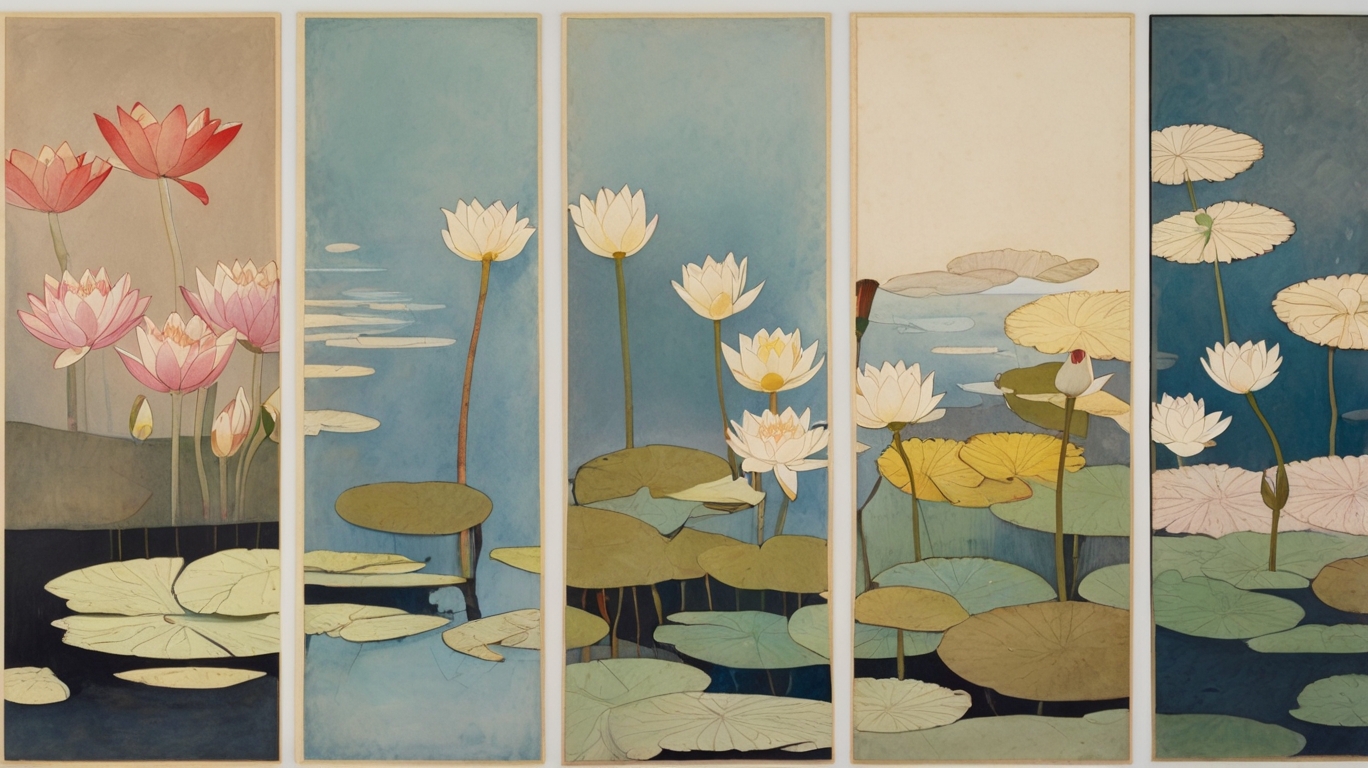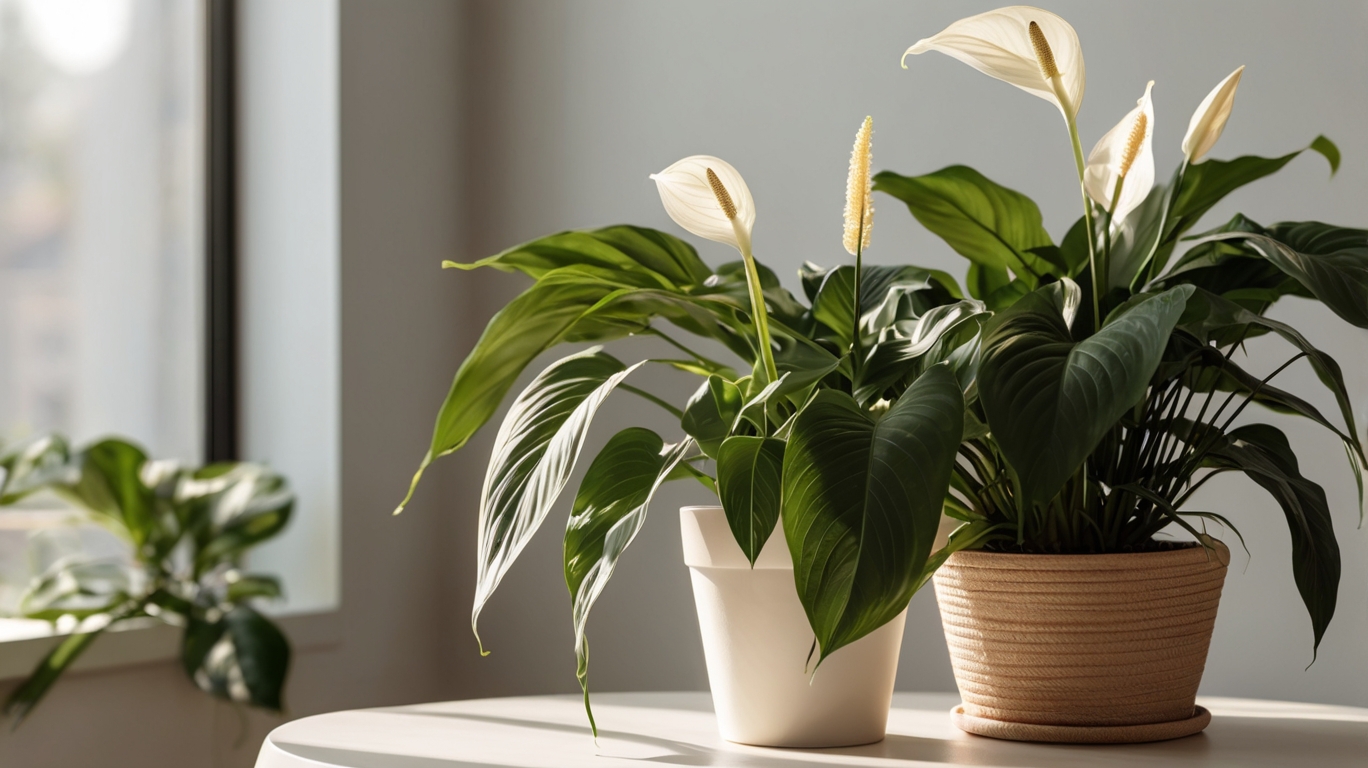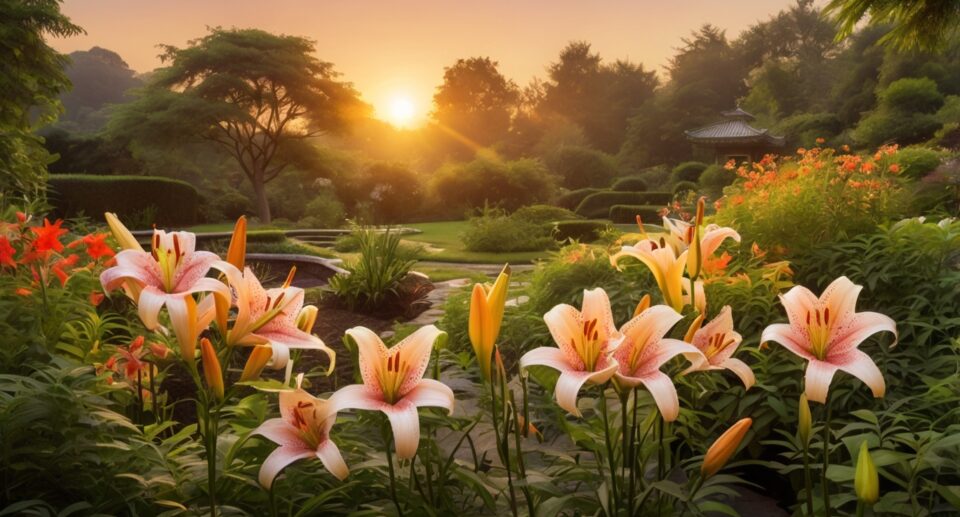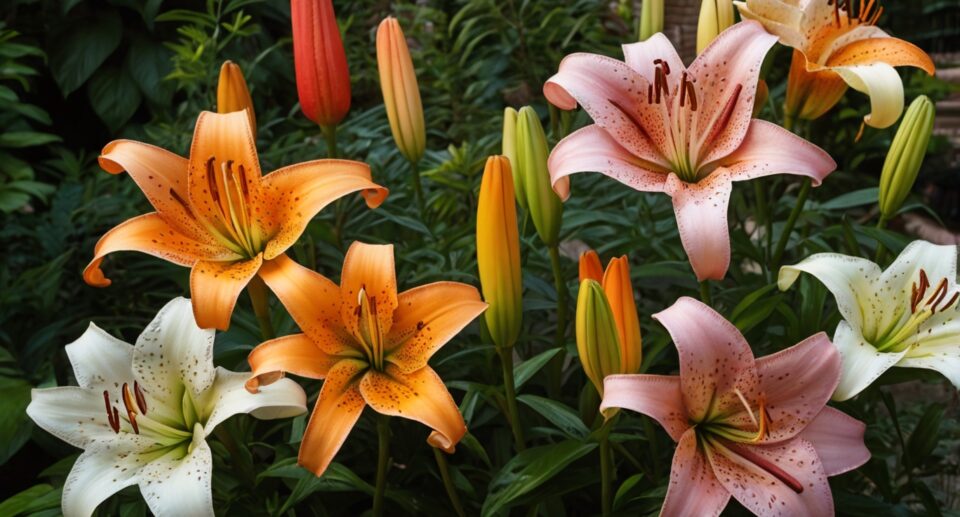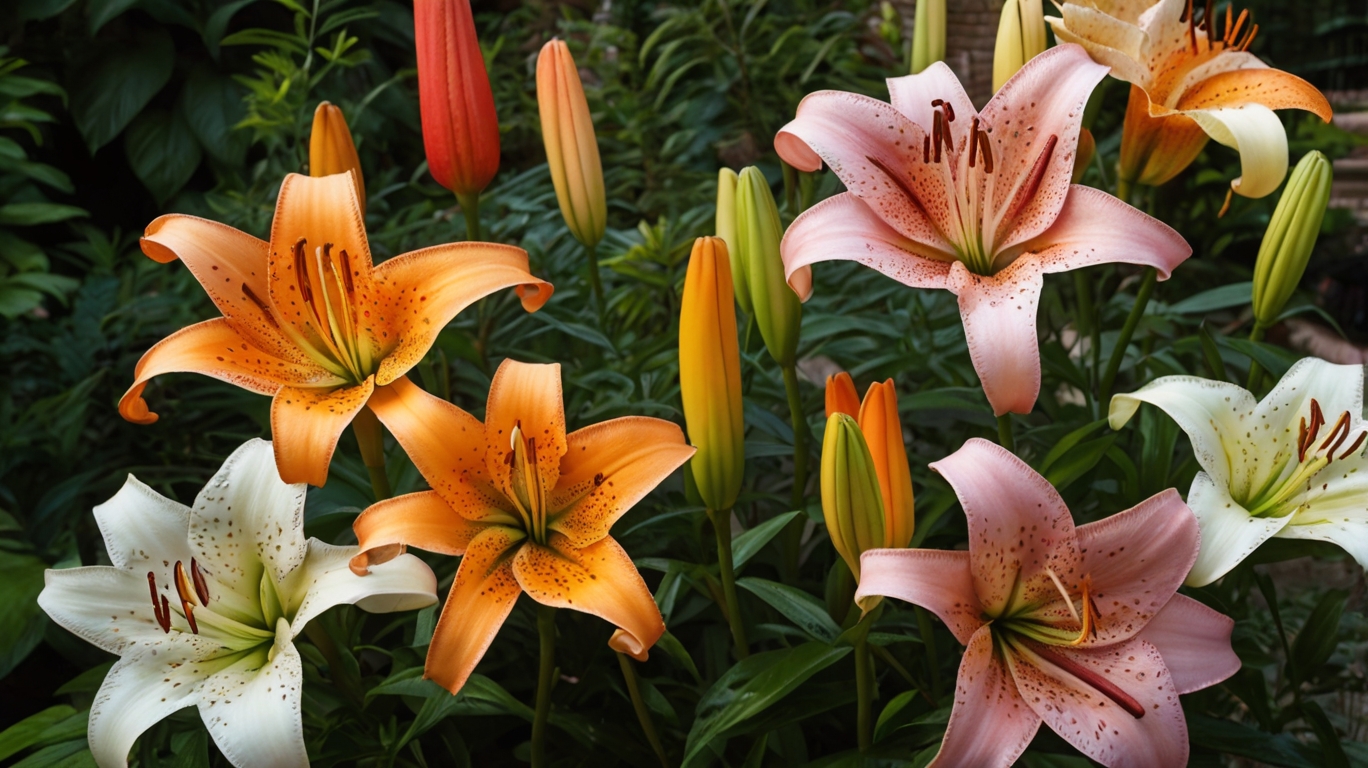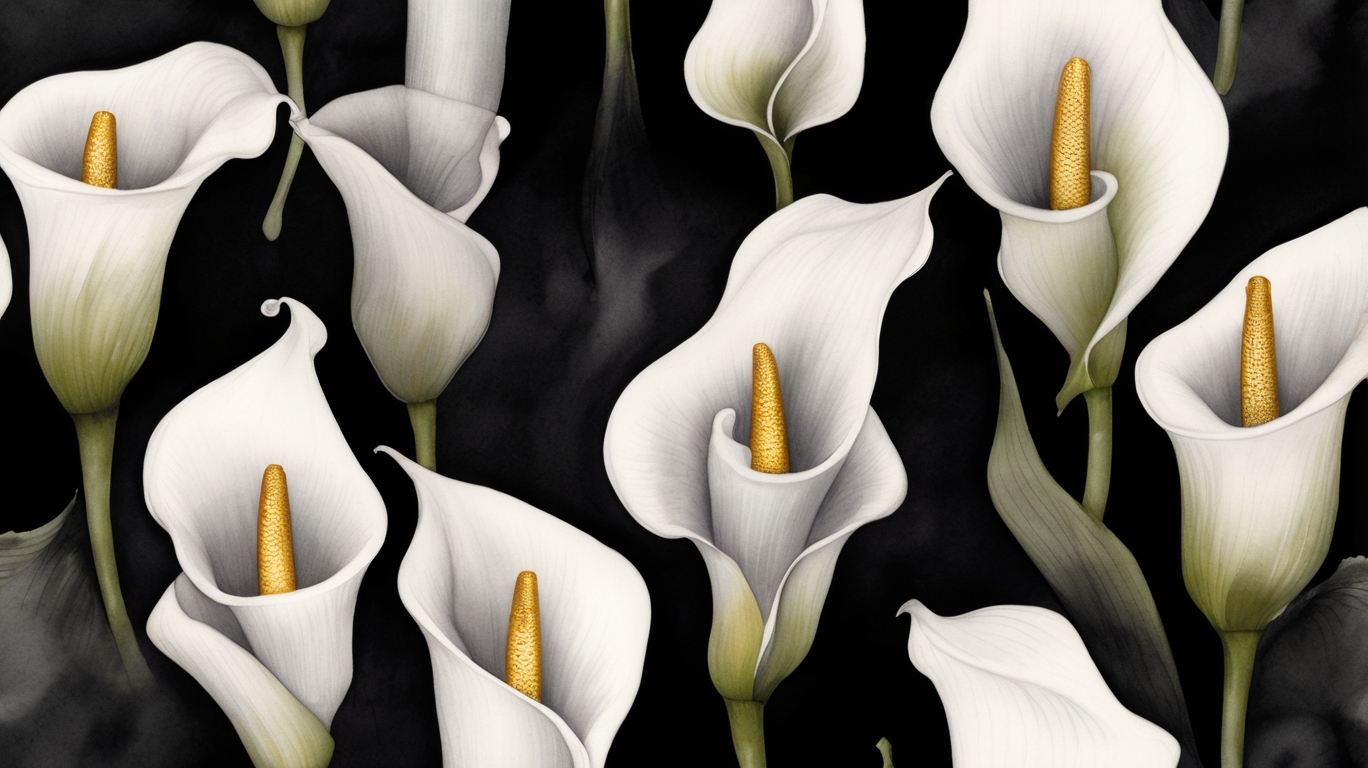What Does a Lily Flower Look Like? A Detailed Guide #1
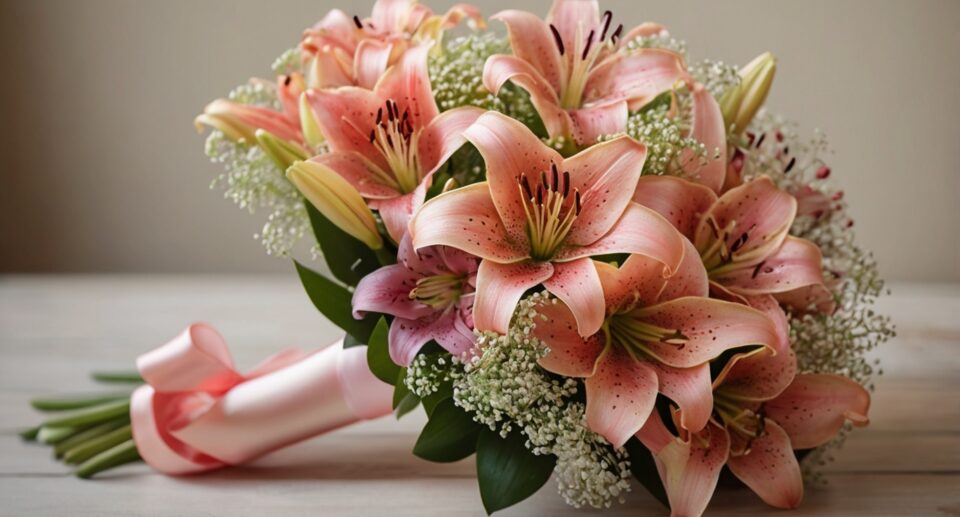
Introduction to the Lily Flower
The lily flower, widely celebrated for its timeless beauty and symbolism, belongs to the genus Lilium under the family Liliaceae. Native to the temperate regions of the Northern Hemisphere, lilies have captivated humans for centuries with their diverse colors, intricate petal arrangements, and sweet fragrances. These perennial flowers are often used in gardens, floral arrangements, and cultural rituals, making them one of the most cherished blooms worldwide.
Lilies are identified by their towering stems, which support clusters of large and trumpet-shaped blooms. Each flower typically features six petal-like tepals, which can be spotted, striped, or plain depending on the species or hybrid variety. The vibrant hues of Lily Flower petals include shades such as white, pink, yellow, red, orange, and even purples, offering a dramatic display of nature’s palette. In the center of the bloom, long stamens crowned with pollen-laden anthers add a contrasting depth to the flower’s overall appearance.
The plant thrives in well-drained soil and prefers sunny to partially shaded environments. While classified as bulbs, lilies store nutrients in their fleshy scales, enabling them to withstand dormant seasons before blooming anew. Beyond their physical attributes, lilies carry rich cultural and spiritual meanings. They symbolize purity, fertility, renewal, and devotion in various traditions, often gracing weddings, funerals, and religious ceremonies.
Some common varieties include Asiatic lilies, Oriental lilies, trumpet lilies, and tiger lilies, each offering unique characteristics in size, fragrance, and coloration. Recognizing a Lily Flower involves observing its funnel-like shape, elegant upward-facing blooms, and the contrasting pistils and anthers that seem to share in its splendor. These features contribute to the lily’s status as a botanical marvel cherished in both natural and cultivated landscapes.
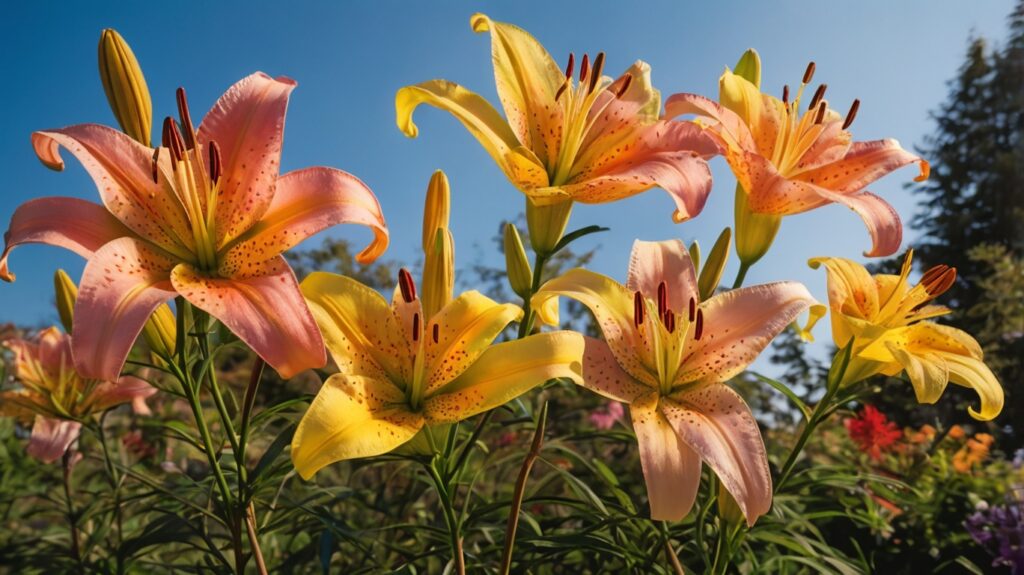
The History and Cultural Significance of Lilies
Lilies have a rich history that spans centuries, rooted in mythology, art, religious symbolism, and cultural traditions across the globe. Revered for their elegance and beauty, these flowers have played a significant role in human expression and beliefs.
The origins of Lily Flowers can be traced back to ancient civilizations, where they held unique meanings. In Greek mythology, the Lily Flower was said to have sprung from the milk of the goddess Hera, symbolizing purity and innocence. The delicate bloom became associated with femininity, divine beauty, and even fertility. Similarly, in Roman culture, lilies were often depicted in frescoes and mosaics as a symbol of wealth and nobility.
Religious symbolism has long been tied to the lily. In Christianity, the white lily, often referred to as the Madonna Lily, represents the Virgin Mary and her qualities of chastity and virtue. Lily Flowers frequently appear in Christian art as a motif of resurrection and the promise of eternal life. During Easter celebrations, lilies are popularly used to decorate churches, underscoring their association with renewal and hope.
Beyond religion and myth, lilies hold cultural significance in various parts of the world. In China, lilies are symbols of good fortune and are commonly offered at weddings to wish prosperity and abundance. In Victorian England, they represented refined beauty and were often part of intricate floral arrangements. Today, lilies remain a popular choice for bouquets and gardens due to their timeless appeal.
Artists and poets have repeatedly drawn inspiration from lilies for their striking appearance and symbolic meanings. From Claude Monet’s “Water Lilies” to poetic verses honoring their grace, these flowers have become enduring symbols of love, mystery, and perfection. With their widespread and enduring cultural importance, lilies continue to captivate hearts and minds around the world.
Varieties of Lily Flowers: Understanding the Diversity
Lily flowers are celebrated for their beauty and distinctive forms, with a wide array of varieties that belong to the genus Lilium. These varieties are categorized based on their shapes, growth patterns, colors, and native habitats. Each type of lily flower brings unique characteristics, making this flower group incredibly diverse.
Asiatic Lilies
Asiatic lilies are among the most popular types due to their vibrant colors and adaptability. They are early bloomers, typically flowering in late spring or early summer. These lilies demonstrate upward-facing blooms in various hues such as yellow, pink, orange, and red. Asiatic lilies grow well in a range of climates and are prized for their lack of scent, making them suitable for individuals sensitive to strong fragrances.
Oriental Lilies
Oriental lilies are known for their large, trumpet-shaped blooms and intense fragrance. These lilies bloom later in the season, usually from mid to late summer. Their flowers often feature intricate patterns or spots with colors ranging from white and pale pink to deep crimson. They are taller than Asiatic lilies and are commonly used in ornamental gardens and floral arrangements for their striking appearance and aromatic appeal.
Trumpet Lilies
Trumpet lilies, as the name suggests, are characterized by their elongated trumpet-shaped flowers. They are highly fragrant and grow to impressive heights. Their blooms are predominantly white or pastel, with some varieties possessing yellow or peach tones. These lilies thrive in well-drained soils and are a favorite for roadside planting and large garden displays.
Martagon Lilies
Martagon lilies, also called Turk’s cap lilies, are distinguished by their downward-facing, reflexed petals. These blooms appear in clusters on tall stems, creating an elegant, chandelier-like effect. They often feature speckled patterns and can be found in shades of purple, pink, orange, and yellow. Martagon lilies are known for their shade tolerance, thriving in woodland gardens or partially shaded areas.
Hybrid Lilies
Hybrid lilies are a fusion of different species, bred to combine desirable traits. Examples include LA (Longiflorum-Asiatic) and OT (Oriental-Trumpet) hybrids. LA hybrids inherit the vivid colors of Asiatic lilies and the larger blooms of Lilium longiflorum, while OT hybrids combine the fragrance and size of Oriental lilies with the robustness of Trumpet lilies. These hybrids cater to a variety of aesthetic preferences and growing conditions.
This diversity allows lily flowers to adapt to various garden landscapes, climates, and purposes. Their wide-ranging forms make them a versatile choice for gardeners and floral enthusiasts alike.
Anatomy of a Lily Flower: Key Features to Recognize
The lily flower, belonging to the genus Lilium, is celebrated for its distinct structure that sets it apart from many other blooming plants. Understanding its anatomy reveals why this flower is such a captivating part of nature’s design.
1. Petals and Tepals
Lily flowers typically feature six petal-like structures known as tepals, which are a combination of petals and sepals. These are arranged in two overlapping whorls of three, giving the flower its characteristic star-like symmetry. Tepals often exhibit vibrant colors such as white, orange, pink, or yellow, sometimes adorned with unique speckles or streaks. This vivid coloration plays a crucial role in attracting pollinators.
2. Stamen and Anther
The reproductive anatomy of a lily flower is accentuated by its prominent stamens. The stamens consist of filament-like stalks topped with anthers that contain pollen. Anthers in lilies are large and may exhibit bold, contrasting colors, making them visually distinct.
3. Pistil and Stigma
At the center of the flower lies the pistil, the female reproductive organ. It features an elongated style leading to a sticky stigma at the top, which traps pollen during fertilization. The base of the pistil houses the ovary, where seeds develop after pollination.
4. Nectar Base
lily flowers often secrete nectar from glands located at the base of their tepals or within their floral tubes. This feature attracts pollinators such as bees, butterflies, and hummingbirds, facilitating the plant’s reproductive cycle while adding ecological value.
5. Linear Leaves
The foliage of lilies is linear, lance-shaped, and alternates in an arrangement along the stem. These leaves form an integral part of the plant by aiding in photosynthesis while complementing the tall, slender appearance of the bloom.
6. Bulb-Based Roots
Lilium plants grow from scaly bulbs located underground. These bulbs serve as storage organs, enabling the plant to survive dormancy periods and regenerate during the next growing cycle.
Each part of the lily flower plays a vital role, supporting its survival, growth, and reproduction.

Colors of Lilies: A Spectrum of Beauty
Lilies are renowned for their breathtaking variety of colors, each offering unique visual appeal and symbolic meaning. From soft pastels to vibrant, bold hues, lilies cater to countless tastes and occasions, making them a favorite for gardens, bouquets, and floral displays.
Common Colors and Their Characteristics Of Lily Flowers
- White Lilies: Known for their purity and elegance, white lilies often symbolize innocence and renewal. Their pristine beauty makes them popular in weddings and memorial arrangements. The petals are smooth and luminous, reflecting light effortlessly, which adds a serene quality to the flower.
- Pink Lilies: These charming blooms convey love, admiration, and femininity. Pink lilies range from pale blush tones to deep rosy shades, adding warmth and texture to any floral composition. Their subtle yet striking appearance makes them ideal for expressing affection.
- Yellow Lilies: Representing cheerfulness and gratitude, yellow lilies brighten any setting with their sunny palettes. Their rich, golden hues exude positivity and are frequently used in festive arrangements. The bold color often draws attention and energizes the environment.
- Orange Lilies: These vibrant flowers symbolize passion and confidence. With their fiery tones, orange lilies create dynamic visual interest and pair beautifully with contrasting or complementary colors. Their boldness makes them particularly popular in modern designs.
- Red Lilies: Associated with love and passion, red lilies are often chosen to convey deep emotions. They stand out with their intense coloring and velvety textures, making them a stunning addition to romantic floral arrangements.
- Purple Lilies: A symbol of royalty and admiration, purple lilies infuse regal charm into any display. From soft lavender tones to deep violet shades, these lilies offer a sense of sophistication and uniqueness.
Uncommon and Hybrid Colors
Lilies also appear in less conventional hues, such as green, peach, and even multicolored varieties. Hybrid lilies often feature speckled petals or gradient tones, where one color transitions seamlessly into another. These unique combinations enhance their aesthetic allure, appealing to those seeking something truly distinctive.
With their vast palette of colors, lilies provide endless possibilities for artful expression. Their ability to harmonize with other flowers or stand out on their own solidifies their role as timeless icons in the world of flora.
Petal Shapes and Patterns: What Makes Each lily flower Unique
Lilies are celebrated for their intricate petal shapes and diverse patterns, which contribute to their unrivaled beauty. The petals of a lily flower can vary significantly depending on the species or variety. While many lilies showcase the classic trumpet shape, others exhibit more unconventional forms such as bowl-shaped, star-shaped, or recurved petals that curl backward, creating a distinctive appearance.
The edges of lily flower petals also play a role in distinguishing each type. Some varieties feature smooth, unbroken edges, while others have slightly ruffled or frilled margins. These edges add a textural element that enhances the visual appeal. Additionally, the depth and curvature of the petals generate a sense of dimensionality, making each bloom appear dynamic and lively.
Lily flower petals often feature striking patterns, including freckles, streaks, and gradients. The spotted or freckled petals, commonly found in Asiatic lilies, serve to create a playful and intricate design. These freckles are typically clustered near the center and gradually fade outward, mimicking nature’s artistry. Streaks or veins, often present in Oriental lilies, direct the eye toward the heart of the flower, accentuating the bloom’s symmetry and vibrancy. Gradations of color, blending from one hue to another, offer a subtle yet stunning visual effect in lilies like the Stargazer.
Another factor contributing to the diversity of lily flower petals is the color palette. From soft pastels to radiant oranges and purples, lilies can exhibit solid colors or multi-tonal effects. Petal shapes and patterns work together with this spectrum to create uniquely appealing varieties. This interplay between form and design ensures that no two lilies feel identical, celebrating individuality in each bloom.
Stem, Leaves, and Growth Habits of Lily Flower
Lilies, belonging to the genus Lilium, are perennial flowering plants distinguished by their sturdy, upright stems. The stems of lilies typically emerge from underground bulbs and play a crucial role in the plant’s overall structural support. They are smooth and fleshy, often varying in shades of green depending on the species and growing conditions. Some taller species may develop stems that reach heights of up to six feet, while dwarf varieties remain closer to the ground. These stems also serve as conduits for nutrient transportation from the bulb to the flowers and leaves above.
The leaves of lilies exhibit distinct characteristics that make them easily identifiable. They are usually narrow and lance-shaped, arranged in an alternating or whorled pattern along the stem. Depending on the species, the leaves may be either glossy or matte, with smooth edges. Their shade of green can range from light to dark, enhancing the plant’s ornamental appeal. In certain species, the leaves may carry subtle longitudinal veins that increase their texture and aesthetic value. These leaves contribute to the plant’s photosynthesis process, ensuring its energy requirements are met for robust flowering.
Lilies grow upright and exhibit growth habits that vary widely based on the species and cultivar. Most lilies produce multiple flowers on a single stem, creating a striking vertical display. They thrive in well-drained soil and are known for their rapid growth once optimal conditions are met. Some species can spread via bulb offsets, leading to natural propagation. Additionally, lilies require consistent sunlight for healthy growth, although partial shade may suffice for certain varieties. Their adaptability allows them to flourish in diverse climates, making them popular in gardens worldwide.
Where Do Lilies Grow? Habitat and Gardening Requirements
lily flowers (Lilium spp.) thrive in a wide range of natural habitats and can adapt to diverse cultivation conditions in gardens. These perennial flowers are native to the temperate regions of Europe, Asia, and North America. In the wild, they typically grow in areas with well-drained soil, including woodland clearings, meadows, and mountainous regions. Lilies prefer moderate climates with distinct seasons, as cold winters facilitate dormancy and warm summers encourage vibrant blooms.
lily flowers require specific conditions to flourish in gardens. They grow best in areas with full sunlight or partial shade, depending on the species. Most lilies demand soil that is rich in organic matter, slightly acidic to neutral, and with excellent drainage. Stagnant water or overly compacted soil can lead to root rot, significantly impacting growth and flowering. Gardeners often mix compost or sand into dense soil to enhance drainage and create the right texture.
Proper planting depth is crucial for lily flowers, as their bulbs need insulation from temperature fluctuations and protection against pests. Generally, bulbs should be planted at a depth that is 2-3 times their diameter. Spacing is equally important; lilies require adequate room for air circulation and growth, with a minimum of 12–18 inches between bulbs.
Watering needs depend on the climate, but lilies typically prefer consistent moisture without being waterlogged. Mulching ensures moisture retention while protecting the bulbs from extreme temperature shifts. Fertilizing with a balanced, slow-release fertilizer at the start of the growing season benefits their growth. For natural habitats or gardens, lilies flourish when these conditions align seamlessly with their biological preferences.
Common Lily Flower Species and How to Identify Them
Lilies are a diverse genus of flowering plants, and their species are often recognized by distinctive characteristics such as flower shape, size, and color. Below are descriptions of commonly known lily flower species and tips for identification:
1. Asiatic Lilies
Asiatic lilies are among the most popular types, known for their hardiness and vibrant range of colors. These flowers typically bloom earlier in the summer and feature upward-facing blossoms with no fragrance. Each petal is smooth and often adorned with freckles or spots. They come in shades of orange, yellow, red, pink, and white, making them a striking addition to gardens. Their compact height, usually between 2 to 4 feet, helps to distinguish them.
2. Oriental Lilies
Oriental lilies are easily identified by their large, dramatic, and fragrant flowers. These blossoms are typically bowl-shaped or star-shaped and exhibit curled petals. The colors are often rich, including pure white, pink, and deep red hues. Oriental lilies bloom later in the season than Asiatic varieties, generally in mid-to-late summer. They are taller, reaching up to 5 feet, and their intense scent is a key feature.
3. Tiger Lilies
Tiger lilies are recognized by their bold orange blossoms covered in dark spots, resembling the markings of a tiger. They have downward-facing petals that curve backward, giving the flowers a unique appearance. Blooms typically emerge mid-summer, and they are notable for their ability to grow in a variety of soil conditions. These lilies can reach impressive heights of up to 6 feet. Another identifying characteristic is the small bulbils growing along their stems.
4. Trumpet Lilies
Trumpet lilies are named for their trumpet-shaped blooms that arch outward. These flowers are highly fragrant and typically come in shades of white, yellow, or pink. Their robust stems often grow up to 6 feet tall, supporting clusters of blooms. Their elegant, elongated petals and delightful fragrance make them easy to identify, especially during late summer.
5. Calla Lilies
Although not true lilies, Calla lilies are commonly grouped with them due to their name. They are recognized by their distinct funnel-shaped spathes surrounding a central spike or spadix. Calla lilies bloom in a variety of colors, including white, yellow, pink, and deep purple, and they tend to thrive in wet, shaded areas. Their sleek appearance and medium height, typically 1 to 3 feet, set them apart.
The unique attributes of these lilies help gardeners and enthusiasts differentiate the species and cultivate them effectively. Each variety has its own charm, lending beauty and character to landscapes.
How to Distinguish Lilies from Similar Flowers
Lilies often get confused with other flowers that share similar visual characteristics. Knowing how to identify a true lily flower can help avoid mistakes and deepen one’s appreciation for this unique flower. True lilies belong to the genus Lilium and have distinctive traits that set them apart from look-alikes.
Key Features of True Lilies:
- Petal Arrangement True lilies typically have six petal-like tepals, which can be recurved or slightly open, depending on the species. These tepals may feature spots, stripes, or blotches that add to their unique beauty. Flowers like daylilies or tulips may have petals that look similar but differ in structure and behavior.
- Bulbous Roots Lilies grow from scaly bulbs, which distinguishes them from flowers like irises or amaryllis that grow from rhizomes or other root systems. The presence of bulbs with clearly visible layers is a definitive trait.
- Stamens and Pollen True lilies have prominent stamens that extend outward from the bloom, ending in large anthers covered with fine, powdery pollen. Other flowers, like orchids or alstroemeria, may lack this pronounced feature.
- Growth Pattern Lilies grow on upright, unbranched stems with leaves spiraling around the stem. In contrast, flowers like daylilies produce leaves in clumps at the plant’s base, with blooms growing directly from scapes rather than stem-like structures.
Differentiating Lilies from Common Look-Alikes:
- Daylilies (Hemerocallis) Daylilies are commonly mistaken for lilies due to their trumpet-like flowers, but they differ by having strap-like leaves that form in clusters at the plant’s base. Moreover, daylilies’ blossoms last only one day, whereas lily flowers persist for several days.
- Tulips Tulips have cup-shaped flowers with a smooth petal arrangement. Unlike lilies, tulips lack the pronounced, outward-extending stamens and grow from smooth bulbs rather than scaly ones.
- Calla Lilies and Peace Lilies While their names include “lily,” these flowers are not true lilies. Calla lilies belong to the genus Zantedeschia and have a distinctive funnel-shaped spathe. Peace lilies, part of the Spathiphyllum genus, also differ in structure, displaying a single white spathe surrounding their central spadix.
By paying attention to these key distinctions, one can confidently separate lilies from their close imitators.
The Symbolism Behind Lily Flower Colors and Forms
Lily flowers are renowned not only for their vibrant hues but also for the deep symbolism behind their colors and forms. Each variety carries unique meanings, rooted in cultural traditions, religion, and personal sentiments. These meanings help lilies stand out as a preferred choice for ceremonies and gifting occasions.
Lily Flower Colors and Their Symbolism
Different lily flower colors are imbued with distinct significance:
- White lilies: Symbolize purity, innocence, and spiritual enlightenment. They are often associated with weddings and funeral arrangements due to their representation of renewal and peace.
- Pink lilies: Represent admiration, romance, and prosperity. Their delicate shade makes them ideal for celebrations of love, such as anniversaries or congratulatory events.
- Yellow lilies: Convey joy, gratitude, and friendship. These vibrant flowers are suitable for cheerful moments and expressions of appreciation.
- Orange lilies: Signify confidence, passion, and energy. Their fiery color evokes feelings of warmth and enthusiasm, making them popular for bold gestures.
- Red lilies: Represent love, desire, and commitment, standing apart as a powerful statement of affection.
- Purple lilies: Suggest royalty, dignity, and transformation. They are often associated with creative endeavors or marking significant spiritual milestones.
Unique Forms and Their Messages
lily flower forms also contribute to their symbolism. For instance:
- Trumpet-shaped lilies: Traditionally signify harmony and clarity, often featured in spiritual practices or peaceful settings. Their upward-facing blooms are perceived as expressions of hope.
- Turk’s cap lilies: With their curved petals, these are symbols of resilience and adaptability. Their exotic appearance holds deeper connotations of protecting one’s beauty amidst challenges.
- Star-shaped lilies: The striking symmetry of these flowers makes them a representation of perfection and ambition, aligning with themes of achievement.
Throughout cultures, lilies have become powerful emblems of emotion and thought. Whether through their lush colors or specific forms, these flowers invite a personal interpretation alongside their universally recognized meanings.
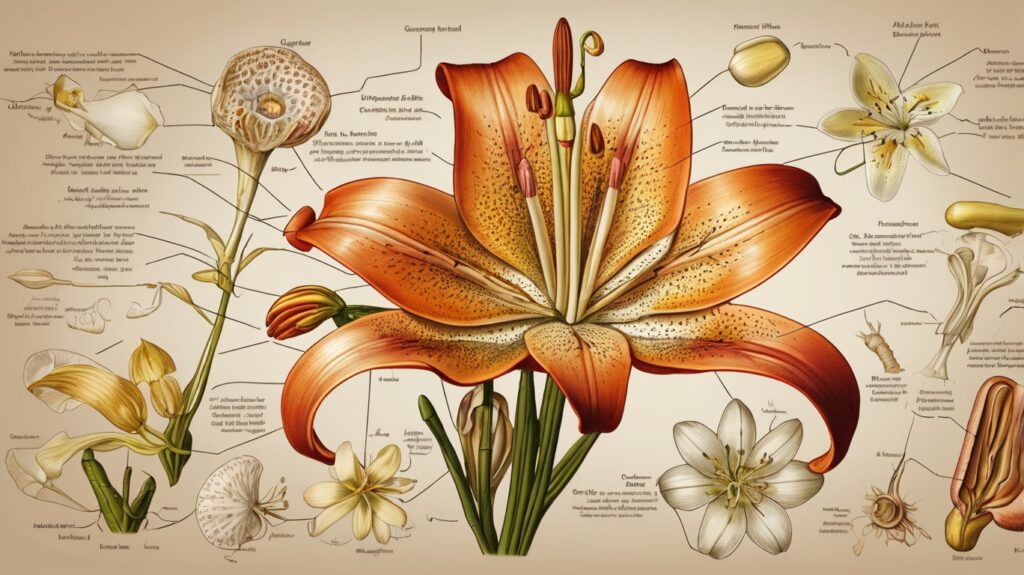
Care Tips to Maintain the Beauty of Lily Flowers
Proper care ensures lily flowers remain vibrant and beautiful for as long as possible. These elegant blooms, whether grown in gardens or kept in vases, require specific attention to preserve their splendor.
Care Tips for Potted or Garden Lilies
- Optimal Soil Conditions Lilies thrive in well-draining soil with a slightly acidic to neutral pH level. Choose a rich, loamy soil to provide essential nutrients while preventing waterlogging.
- Sunlight Most lilies prefer full sunlight, requiring at least 6–8 hours of direct light daily. However, some species, like shade-loving varieties, benefit from partial shade. Keep an eye on the specific needs of the lily flower species being grown.
- Watering Regimen Regular watering is crucial but must avoid overwatering. Ensure the soil is evenly moist, but allow the top layer to dry before the next watering session. Overwatering can lead to root rot, which damages lilies significantly.
- Deadheading Removing spent flowers promotes continued blooming and prevents the plant from diverting energy into producing seeds. Use clean gardening shears for precision trimming without harming the stem.
- Mulching Applying a layer of mulch around the base of lilies helps retain moisture, regulate soil temperature, and suppress weeds. Organic mulches such as wood chips or bark are ideal choices.
Care Tips for Cut Lilies in Vases
- Clean Vase & Fresh Water Begin with a clean vase filled with fresh, lukewarm water. Ensure any leaves below the waterline are removed to prevent bacterial growth.
- Trim the Stems Trim 1–2 inches off the stem ends at an angle to improve water absorption. Re-trim every few days to maximize hydration.
- Add Flower Food Use a packet of flower food to maintain water quality and provide nourishment that prolongs the freshness of cut lilies.
- Keep Away from Direct Sunlight Place the vase in a cool, shaded area. Bright sunlight causes flowers to wilt faster, reducing their lifespan.
Properly caring for lilies can enhance their beauty and longevity, ensuring they remain a stunning centerpiece in a garden or home.
Conclusion: Appreciating the Elegance of Lilies
The lily flower stands as a beacon of grace and elegance within the botanical world. Its distinct trumpet-shaped blooms, often adorned with intricate patterns such as speckles or streaks, create a visual masterpiece. Lilies captivate with their vibrant hues, ranging from pristine whites and blush pinks to rich oranges and deep purples. Their long, slender stems further enhance their stature, giving them the appearance of floral royalty.
The flower’s physical attributes are complemented by its symbolic meanings. For centuries, lilies have represented purity, renewal, and devotion in diverse cultures, solidifying their significance in human tradition. They are revered not only for their aesthetic appeal but also for the emotional connections they evoke. The irresistible fragrance of certain lily flower species amplifies their allure, with scents that frequently offer subtle notes of sweetness or exotic floral undertones.
Lilies also play a vital role in ecosystems, attracting pollinators such as butterflies and bees with their colorful petals and enticing nectar. Their importance in gardens and landscapes extends beyond visuals; they enrich environments with both life and vigor. Many gardeners and floral enthusiasts appreciate the ease with which lilies can adapt to various growing conditions, making them a staple choice across climates.
Such qualities have solidified lilies as a favored choice for home décor, weddings, and elaborate floral arrangements. From their robust beauty to their rich symbolic meanings, lilies truly represent the intertwining of nature’s artistry with humanity’s cultural appreciation. Whether admired in the wild or cultivated in gardens, the lily flower offers endless fascination and charm.


